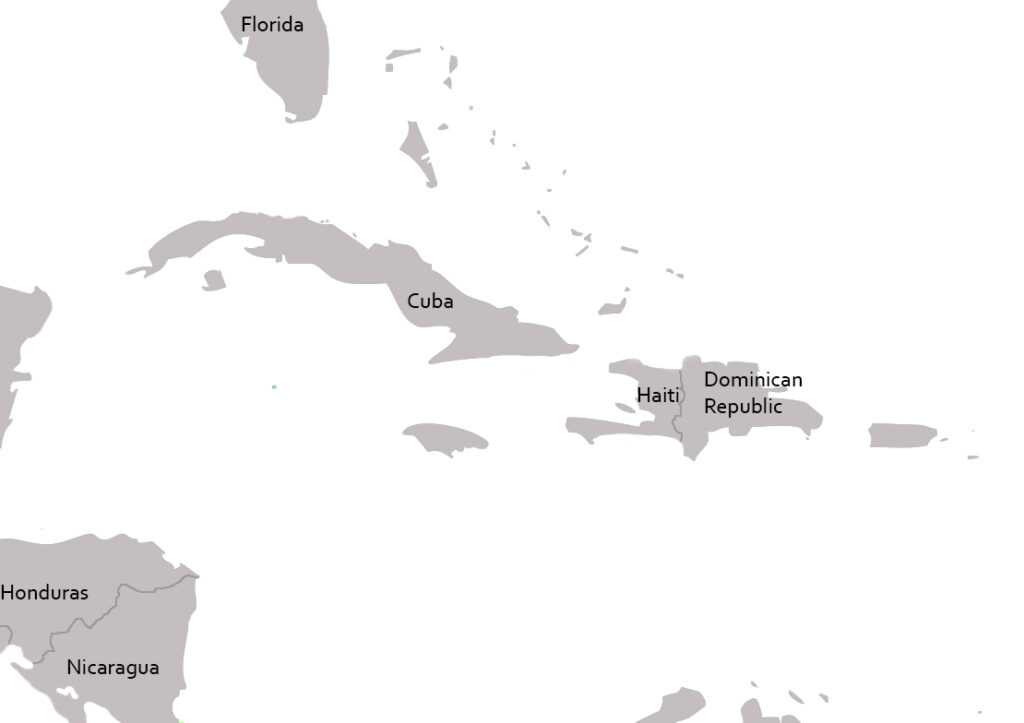U.S. INTERVENTION IN THE CARIBBEAN
Haiti, the Dominican Republic and Cuba.

In this chapter we visit the Caribbean to investigate two very different stories, those of Haiti and Cuba. Before proceeding to the details, some background relevant to the Caribbean…
Before the arrival of Europeans, the Caribbean was populated by Caribs and Arawaks who had moved up from South America.
1492 – In Spain, the Moors of Africa are finally overcome to reassert Christian Dominance after 500 years. After these Crusades, Italian Christopher Columbus is sponsored by Spain to find a new route to India.
16th Century – The Spanish Conquistadores spread across the Americas, decimating the indigenous population with war and smallpox. The start of the Slave Trade, with Africans abducted in their millions to replace the dead.
1588 – Britain defeats the Spanish Armada, gains sea supremacy and takes Antigua, Barbados and Jamaica. The French take Martinique, Guadeloupe and Western Hispaniola (Haiti).
1500-1830 – Slavers kidnap 5 million people from Africa to replace the slaughtered natives.
1700s – Slave revolts – 1734 Jamaica; 1736 Antigua; 1737 Guadeloupe; 1746 Jamaica; 1752 Martinique; 1760 Jamaica; 1761 Nevis; 1763 Surinam; 1765 1769 Jamaica; 1772 Surinam; 1776 Jamaica and Montserrat; and 1791 in Haiti. The latter revolt in Haiti led to the declaration of an independent Haitian republic which made this insurrection against the land-owners the most successful Slave Revolt in History.
1800s – Slave Labour is becoming too uneconomic. It’s becoming trickier to find and extract people from Africa. Sugar beet now being grown in Europe and moves in Europe to ban slavery. Owners realised that paid labourers would behave and not rebel, and also could then be made to pay for their own shelter and food. Maintain power without responsibility.
Independence – 1804 Haiti; 1844 Dominican Republic; 1898 Cuba; 1962 Jamaica and Trinidad.
1833 and 1848 – Abolition of slavery in British and French colonies. 540,000 slaves are set free in British colonies alone over 5 years. Planters compensated by respective Governments.
1838-1917 – 1/2 million Indians and Chinese come as contract labour replacing the former slaves who had left the plantations.
1945 – Caribbean – Britain allows U.S. to build 6 military bases in exchange for 50 old warships marking the transition of power on the American continent.
1975 – TV airtime imported from the U.S. – Jamaica 82%, Barbados 97%, St Kitts 100%.
1985 – 21 U.S. military installations in the Caribbean, There are 30,000 troops in the region to protect heavy U.S. capitalization. Puerto Rico alone has 7 U.S. Bases and 12,000 troops.
U.S.-friendly Governments at this time… Antigua, Barbados, Dominican Republic and Jamaica, to whom the U.S. provides military training and assistance.